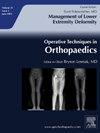All-Inside, Inside-Out, and Outside-In Meniscus Repair Techniques and Outcomes
IF 0.3
Q4 ORTHOPEDICS
引用次数: 0
Abstract
The benefits of meniscus repair are clear when performed in the optimal patient population and tear characteristics. Fundamental principles of meniscus repair remain the same regardless of the fixation technique, including anatomic reduction, circumferential compression and biological stimulation. With the advancement of contemporary all-inside devices, all-inside techniques have gained significant popularity with their ease of use and shorter operative times without the need for an open exposure. The inside-out repair generally remains the gold standard for larger, more extensive or complex meniscus tears due to the greater versatility and allowing for more points of fixation with less iatrogenic damage to the meniscus. Both all-inside and inside-out techniques can be used for middle and posterior third zone meniscal tears. Outside-in repair techniques are generally reserved for the anterior one-third of the meniscus. High strength nonabsorbable braided suture or tape has become the standard for meniscus repair. Contemporary suture passing devices have been developed in more recent years, which may allow for the placement of circumferential compression sutures but with the potential downside of having intra-articular knot stacks on the meniscus. Although outcomes are generally positive, they will vary based on clinical factors including tear pattern, chronicity, tissue quality and knee stability. Complications may occur with each technique, but recurrent tearing or failure is the most common, even in the setting of optimal indications. Orthopaedic sports medicine surgeons should become proficient with a comprehensive armamentarium of meniscal repair techniques to optimize meniscus preservation, especially in younger patients.
全内,内外,外内半月板修复技术和结果
在最佳患者群体和撕裂特征中进行半月板修复的好处是显而易见的。不论采用何种固定技术,半月板修复的基本原则都是相同的,包括解剖复位、周向压迫和生物刺激。随着当代全内装置的进步,全内技术因其易于使用和缩短手术时间而无需开放暴露而获得了显著的普及。由于更大、更广泛或更复杂的半月板撕裂,内向外修复通常仍然是金标准,因为它具有更大的通用性,允许更多的固定点,并且对半月板的医源性损伤更少。全内和由内到外技术均可用于中后第三区半月板撕裂。由外至内的修复技术通常用于半月板前三分之一。高强度不可吸收的编织缝合或胶带已成为半月板修复的标准。近年来,现代缝合装置已经发展起来,它可能允许放置环向压缩缝合线,但有潜在的缺点,即在半月板上有关节内结堆积。虽然结果通常是积极的,但它们会因临床因素而异,包括撕裂模式、慢性、组织质量和膝关节稳定性。每种技术都可能出现并发症,但反复撕裂或失败是最常见的,即使在最佳适应症的设置。骨科运动医学外科医生应熟练掌握全面的半月板修复技术,以优化半月板保存,特别是在年轻患者中。
本文章由计算机程序翻译,如有差异,请以英文原文为准。
求助全文
约1分钟内获得全文
求助全文
来源期刊

Operative Techniques in Orthopaedics
ORTHOPEDICS-
CiteScore
0.40
自引率
0.00%
发文量
40
审稿时长
83 days
期刊介绍:
Operative Techniques in Orthopaedics is an innovative, richly illustrated resource that keeps practitioners informed of significant advances in all areas of surgical management. Each issue of this atlas-style journal explores a single topic, often offering alternate approaches to the same procedure. Its current, definitive information keeps readers in the forefront of their specialty.
 求助内容:
求助内容: 应助结果提醒方式:
应助结果提醒方式:


